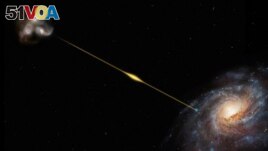26 October 2023
Astronomers have detected radio waves coming from what looks like a joining of galaxies from about 8 billion years ago. The discovery is the oldest-known example of an event that is difficult to explain: a fast radio burst.
In less than a millisecond, this burst released the amount of energy our sun releases in thirty years, scientists said.
The Australian SKA Pathfinder, a radio telescope in the state of Western Australia, detected the burst. And the European Southern Observatory's Very Large Telescope in Chile, one of the most powerful telescopes, found the location of the burst.

This artist's impression, not to scale, illustrates the path of a fast radio burst from the distant galaxy where it originated all the way to Earth in this handout picture obtained on October 20, 2023. (ESO/M. Kornmesser/Handout via REUTERS)
A fast radio burst, or FRB, is a kind of radio-frequency electromagnetic radiation. It lasts less than a millisecond but outshines most other sources of radio waves in the universe. Radio waves have the longest wavelengths in the electromagnetic spectrum.
Ryan Shannon, an astronomer at Swinburne University of Technology in Australia, was a co-leader of the study published recently in Science.
He said radio waves in FRBs are similar to those used in microwave ovens. And he added that this FRB had the same amount of energy needed to microwave "a bowl of popcorn twice the size of the sun."
Until now, the oldest-known such burst dated to 5 billion years ago, making this one 3 billion years older. The universe is about 13.8 billion years old. For comparison, Earth is about 4.5 billion years old.
In seeing objects and events from long ago, researchers look across large distances, making this burst also the farthest of any FRB ever detected.
"We now know that fast radio bursts have been around for more than half the age of the universe," said study co-leader Stuart Ryder of Macquarie University in Australia.
Researchers first discovered fast radio bursts in 2007.
The most likely source is a special kind of "neutron star, called a magnetar. These stars ... are some of the most extreme objects in the universe, which you would need to produce such extreme bursts," Shannon said.
"There are more energetic events in the universe, associated with stellar explosions or a black hole shredding a star apart. But FRBs are unique in that they produce all their energy in radio waves, with nothing seen in other bands - optical light or X-rays for example - and that the signals are so short," Shannon added.
They also are more common, Shannon explained, with around 100,000 thought to happen somewhere in the universe daily. Far fewer have been detected, Shannon said, and only around 50 - including this one - have been traced back to the galaxy where they began.
The scientists said that studying these bursts can help to detect and measure the large amount of matter believed to populate the large distances of space between galaxies.
I'm John Russell.
Will Dunham reported on this story for Reuters. John Russell adapted it for VOA Learning English.
________________________________________________
Words in This Story
detect -- v. to discover or notice the presence of something
burst – n. a short period of producing or doing something that begins suddenly
millisecond – n. one-thousandth of a second
location -- n. a place or position
neutron star – n. a small and very dense kind of stellar object
stellar – adj. of or relating to the stars
shred – v. to cut or tear (something) into long pieces
unique -- adj. used to say that something or someone is unlike anything or anyone else
trace -- v. to follow something back to its cause or beginning